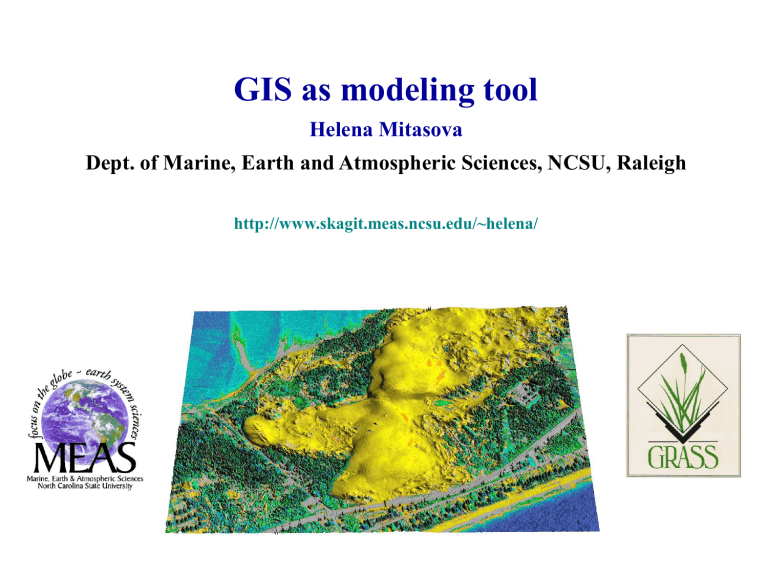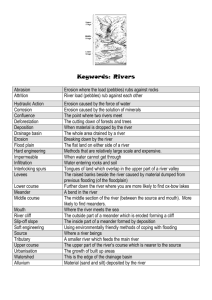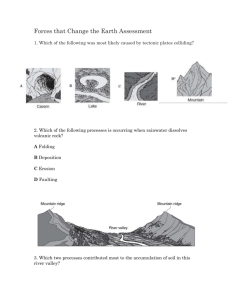GIS as a Modeling Tool

GIS as modeling tool
Helena Mitasova
Dept. of Marine, Earth and Atmospheric Sciences, NCSU, Raleigh http://www.skagit.meas.ncsu.edu/~helena/
US Dept. of Labor identified geotechnology as one of the three most important emerging and evolving fields, along with nanotechnology and biotechnology."
Nature, vol. 427, Jan. 2004, p. 376.
New trends
* Revolution in mapping technologies (laser scanning, multispectral imagery...)
* Automated monitoring stations: meteorology, oceanography, surface water (Rivernet, USGS, DOT), groundwater, etc.
* On-line distribution of data, near real time data availability, WebGIS
* Multidimensional dynamic GIS: replacement of 2D static representation of landscape by a 3D dynamic representation;
H. Mitasova
GIS technology and landscape processes
Monitoring modern mapping technologies – LIDAR, IFSARE, multispectral imagery, RTK-GPS, automated sensors
Analysis and risk assessment integration of data from multiple sources, spatial analysis, visualization : identifying the problem areas, trends, risks
Prediction of impacts spatially distributed numerical modeling, simulations
Planning and decision support information and tools for management of natural and socioeconomic resources
H. Mitasova
Jockey's Ridge State Park
Established in 1975 to save the dunes, it was believed to be stable.
It is now completely surrounded by development and it migrates faster than expected, threatening nearby homes and roads
Challenge: keep the naturally migrating dune within the park
2003 view from NE
H. Mitasova
1995 (yellow) migration rate: 3m/y
1995 (yellow)
1999 (red) migration rate: 7m/y
D
Jockey's Ridge evolution
1974 and 1995 photogrammetric data courtesy Dr. Overton, NCSU
1999 ATM lidar:
USGS/NASA/NOAA
H. Mitasova
Jockey
’ s Ridge:
1998 DOQQ, 1999 LIDAR, 2002 RTK-GPS
1. East ridge needs immediate attention as it is moving fast towards the road
2. The fences in Central section work as elevation there increases
3. Main ridge is rapidly flattening and moves fast SW sand pavement vegetation
H. Mitasova
Jockey
’ s Ridge evolution: natural + man-made
Dune rolled over minigolf
C
2000 2002 2003 winter 2003
“Nature tries to shift OB but man keeps shoveling it back”
Cornelia Dean, NYT Sept. 22
H. Mitasova
Development of SW Centennial Campus
Combining the GIS and CAD data to create digital models of the current and future landscapes
1993 2001 construction future
Pre-development 1993 overland flow and location of sediment control structures constructed wetland check dams future school location previously a NCSU farm detention area
Overland flow and net erosion/deposition discharge m 3 /s
0.002m
3 /s erosion deposition
/m 2 s
0.7m
3 /s
0.001kg/ms erosion=87kg/s
0.01-6.0kg/ms erosion=968kg/s main impact of disturbance is outside construction site: stream erosion within protective buffer
Overland flow and net erosion/deposition impact of disturbance caused by concentrated water flow that is not sufficiently reduced by the buffer, maximum erosion rates are within the protective buffer
Discharge m 3 /s
Extended, high infiltration buffers can reduce the impact
Erosion deposition
/m 2 s
Erosion 142kg/s compared to 968kg/s
Tangible GIS
MIT media Laboratory
Tangible GIS
MIT media laboratory







